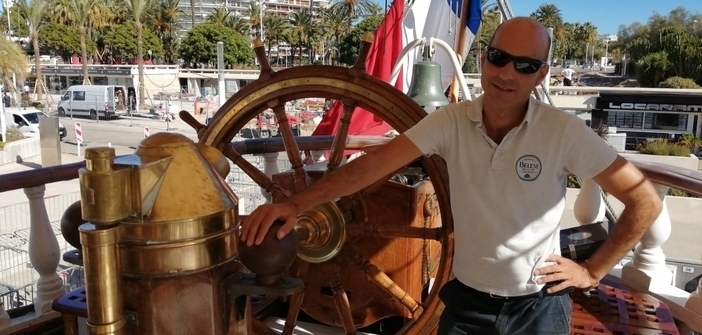Aymeric Gibet, 40 years old, a sailor from Nantes trained in Marseille, has been the captain of the famous French sailing ship, the Belem, since 2016. After beginning a journey in 2011, he was promoted from first officer to captain upon his return four years later. Mr. Gibet has the pleasure of sharing his professional experience with us.
Interview with the captain of a three-masted ship that has over 120 years of history.
Why did you choose the Belem?
It wasn’t necessarily a choice. I attended the merchant marine officer school in Marseille. There, we are trained to navigate any vessel (oil tanker, cruise ship, container ship…). The Belem is the only sailing ship registered with the merchant marine. When I was offered the command of the vessel in 2016, I didn’t hesitate.
What is your best and worst memory aboard the Belem?
I have several. There are mainly beautiful moments. For example, weddings that take place aboard the ship, or the emotion of a trainee who, after spending a certain period with the crew, leaves us in tears. At those times, we are all very proud of our team and the ship. When the ship docks to applause, the Belem and its crew are celebrated.
With challenging or particular situations due to the weather, or commercial pressure, there are always doubts when maneuvering the sailing ship. I have a constant pressure regarding the possibility of a major error on the second oldest sailing ship in the world.
Is the Belem like a second home for you?
Yes, like for any sailor. I spend six months of the year aboard the Belem. I first set foot on it as a professional in 2005. I rose through the ranks and am now in my fifth year of command. I know the Belem very well, I have many memories there.
What is it like to be the captain of the oldest sailing ship in France?
Being a captain is first and foremost a great responsibility. We are responsible for the crew, a ship, and its operating system. The Belem is a ship that has been around for 124 years and is well maintained. It’s built to last through the centuries, and it must be preserved with its heritage for future generations. Sailing it on the seas does, in a way, make it vulnerable, which is why maintenance work is necessary to keep the Belem in good condition.
In terms of its value, it is important to restore its historical parts, things that you can’t see on other ships. Budget-wise, it is quite expensive for us, but it’s the only way to properly maintain the ship and ensure safety on board.
How is the crew? Are there social bonds?
Aboard a ship, there is no hierarchy problem. Any sailor will tell you that you have to deal with the weather, the ship, and its captain. Here, when people ask us something about the Belem, we are happy to pass on the information, even if it is repetitive. During public visits, we receive 1,200 visitors daily. Therefore, we expect that we will be asked the same questions every day.
It’s our duty to be patient and respond honestly and respectfully to tourists’ requests. The same goes for trainees and apprentice sailors who address us formally at first and end up using informal language by the end.
What makes this ship special apart from its age?
A sailing ship is always special. The sails replace the engines. There comes a time during the journey when the engines are turned off, and the sails take over, depending on the weather conditions (wind, storm…).
The duty to pass on information about the ship to the “landlubbers” is equally special. Not to mention all the stopovers. Personally, I don’t know of a single merchant marine commerce ship that makes stops in Marseille, Cannes, Bordeaux, Nantes… These are unique stopovers for us. When we dock in a new city, the Belem and its crew are welcomed like royalty.
What is the most symbolic or historical part of the ship?
The Belem may be known as the largest French sailing ship, but it’s small compared to other large international sailing ships. On its own, it appears large, but in comparison, it’s another story. The ship is not imposing by its hull, but at sea, it is highlighted by its sails.
For me, the rigging and the height of the masts make the Belem impressive.
Do you have a message to convey, especially to young people who dream of having your position?
I understand that becoming the captain of a ship is one of the wildest childhood dreams. I myself visited the Belem with my parents in 1987. Being its captain is like being a fighter pilot. I know it makes children dream, and it’s a widely accessible profession but not one that people think about much.
It’s a profession that demands many sacrifices in one’s private life. It’s possible that, once you set sail, you won’t see your loved ones for a long time (six months).
Where there’s a will, there’s a way! Becoming the captain of a ship is not too complicated a project. It’s a demanding role not in terms of access but rather in terms of the rigor of work. The real challenges begin once you reach the position.


